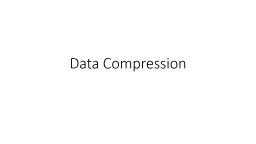PPT-Data Compression “The Gold-Bug”
Author : phoebe-click | Published Date : 2018-09-22
533056 48264 4806488 60851883885468896 84855249562548 84069285684194808188 14885448552880681948884
Presentation Embed Code
Download Presentation
Download Presentation The PPT/PDF document "Data Compression “The Gold-Bug”" is the property of its rightful owner. Permission is granted to download and print the materials on this website for personal, non-commercial use only, and to display it on your personal computer provided you do not modify the materials and that you retain all copyright notices contained in the materials. By downloading content from our website, you accept the terms of this agreement.
Data Compression “The Gold-Bug”: Transcript
Download Rules Of Document
"Data Compression “The Gold-Bug”"The content belongs to its owner. You may download and print it for personal use, without modification, and keep all copyright notices. By downloading, you agree to these terms.
Related Documents












